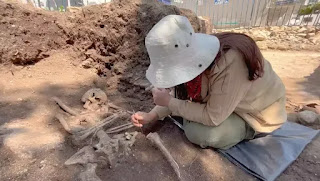Archaeologists have discovered three human figurines dating back 7,700 years during the excavation works in the Ulucak Mound in the western province of İzmir.
Özlem Çevik, the head of the excavation team, stated that three figurines have quite different features from other findings typically found during ongoing excavations at Ulucak Mound, which is the oldest settlement in İzmir, dating back 8,850 years.
"Usually, we come across female figures with large hips holding their chests in the field. However, this year's excavations have yielded intriguing figures. We believe that two of these figurines are a couple, and they are dressed in similar costumes. They wear hats and have pointed noses," Çevik explained.
"The female figurine is depicted carrying a baby in her arms. Similar examples are seen in the Balkans, but they appear much later. These are not well-known pieces specific to Ulucak or Anatolia; they are more commonly found in the Balkans."
The figurines were made from fired clay, and further research on the findings has confirmed their dating to 7,700 years ago, she added.
Systematic excavations at Ulucak Mound, which was first discovered by British researcher David French in 1960, started in 1995 under the leadership of Prof. Dr Altan Çilingiroğlu, with the joint participation of Ege University Department of Protohistory and Pre-Asia and İzmir Archeology Museum.
In the excavations, a large number of ceramic pots, tools made of ganister, stone weapons, mother goddess figurines, and anthropomorphic pots were unearthed.
(Source: Hürriyet Daily News)

